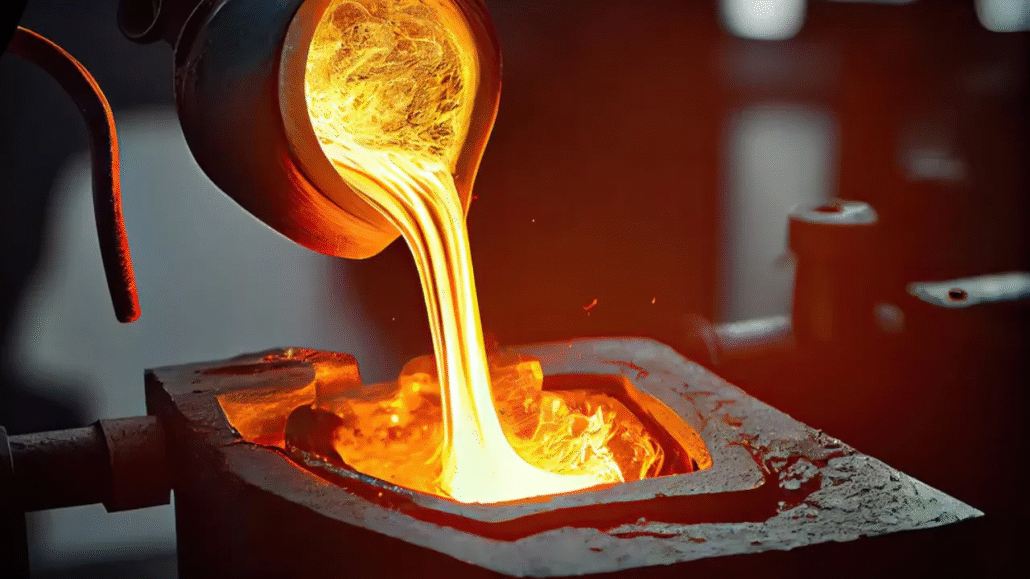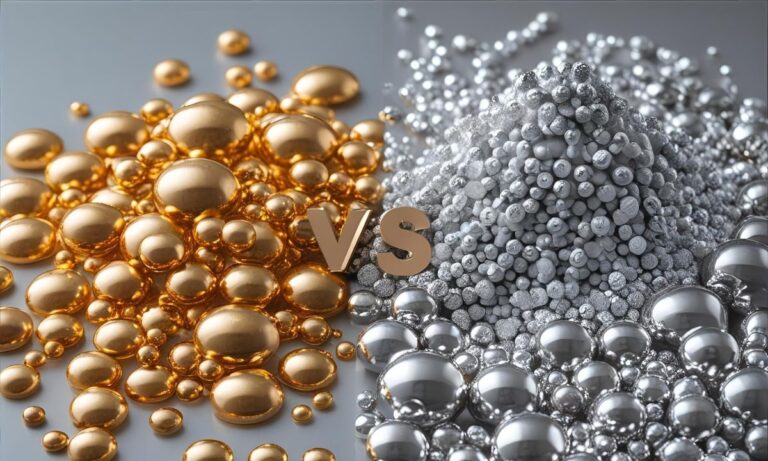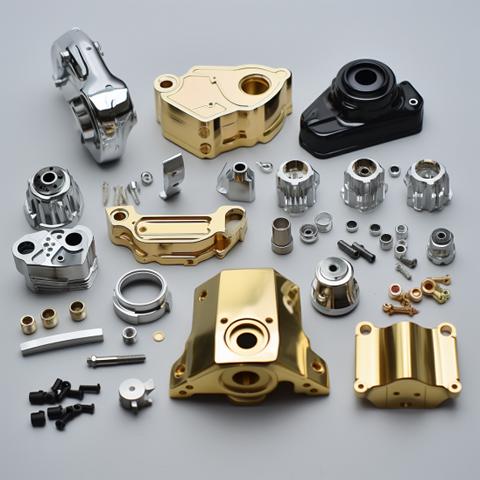ホットチャンバー・ダイカストは、金属部品を非常に高精度に、また表面の優れた仕上げを実現するために広く使用されている、非常に効果的な製造プロセスです。特に亜鉛、マグネシウム、鉛を含む合金のような融点の低い金属の鋳造に適しています。射出システムが溶融金属に浸漬されるという事実に代表されるように、高速サイクルタイムと大量生産の経済性が可能である。
コールド・チャンバー・ダイカストとホット・チャンバー・ダイカストについて鋳物を検討するとき、同じような比較対象が必ずひとつ出てくる。どちらも加圧ダイカストの一種であるが、設計、用途、使用材料の適合性などの点で大きく異なる。例えば、ホット・チャンバー・ダイカストは、炉を機械に置き換えた高速ダイカストです。そのため、低融点金属の制約がある。逆に、コールド・チャンバー・タイプの機械は、高温の金属が設備に直接触れないため、アルミニウムや真鍮のような高融点の液体に適している。
ホットチャンバーダイカストプロセスは、材料の無駄が少なく、人件費が安く、複雑な形状を高い公差で製造できるのが特徴です。自動車、電子機器、配管、消費者製品などの業界で人気があります。とはいえ、コールド・チャンバー・ダイカストとホット・チャンバー・ダイカストのどちらを使用するかは、使用する材料の種類や部品設計の側面にも左右されます。
の重要な詳細を検証している。 ホットチャンバー・ダイカストその部品、材料、工程の説明、制約、そしてなぜそれが現代の製造業において不可欠な工程なのかという理由。
目次
トグルホット・チャンバー・ダイカストとは?
ホットチャンバーダイカストは、溶融金属を高圧で金型キャビティに注入する金属鋳造技術です。この方法の特徴は、射出機構がどこに配置されているかということです:溶融金属に直接注入されます。サイクルタイムと生産効率は、特に亜鉛、マグネシウム、一部の鉛合金のような低融点の金属では、このセットアップで高いです。
ホットチャンバー。この名称は、射出機構(プランジャーとグースネック)が溶融金属領域と常に接触(充填)していることから、システムのホットチャンバーを表している。プランジャーが下降すると、溶融金属がグースネックを通って金型キャビティに圧縮されます。金属が固まると金型が開き、部品が排出され、このプロセスが無数に繰り返される。
ホットチャンバー・ダイカスト・プロセス
ホットチャンバーダイカストプロセスは、金型の精度が非常に重要な金属部品の製造に利用される高精度で高速な製造技術のプロセスであり、優れた表面仕上げが施される。低融点合金に最も適しており、亜鉛、マグネシウム、鉛は低融点合金の一例である。その主な特徴は、短いサイクルタイムと優れた材料効率である。
ホットチャンバー・ダイカスト・プロセスは、複雑な端部を簡単に、しかも1個あたりの価格が手ごろなことから、主に自動車、電子機器、家電製品、金物産業など、さまざまな製品の製造に広く用いられている。ホットチャンバー・ダイカストプロセスを以下に順を追って説明する:
ホットチャンバー・ダイカスト・プロセス-ステップ・バイ・ステップの概要
1.金属を溶かす
ダイカストは、ダイカストマシンに組み込まれた炉で、金属(通常は亜鉛またはマグネシウム)を溶融成形することから始まります。溶融金属は、鋳造機に直接接続された金属ポット内で一定の温度に保たれます。この絶え間ない熱供給により、鋳造工程は連続的に行われます。
2.インジェクション・システムへの充填プロセス
ホットチャンバーシステムでは、グースネックと呼ばれる部品の一部が水没した状態で溶湯の一部が存在する。射出シリンダー内を流れるプランジャーは、溶湯がグースネックから射出注入孔に湧き出る位置まで後方に引かれる。次のステップでは、この金属を金型キャビティに射出する。
3.溶湯注入
グースネックが充填されると、プランジャーが油圧または空気圧で押し進められ、溶融金属がグースネック・チャンネルを通って金型キャビティ(ダイとも呼ばれる)に押し込まれます。これは、金属が硬化し始める前にキャビティが完全に充填されるように、高い速度と圧力で行われます。
4.鋳型での鋳造と凝固
金型内のこの高温の金属は、金型の比較的冷たい鋼鉄によって素早く冷却される。凝固には、部品のサイズと複雑さに応じて数秒かかります。このステップでは、金型冷却チャンネルが熱の除去を補助し、サイクル速度が低下しないようにし、収縮や気孔などの欠陥が発生しないようにします。
5.金型の排出と開放
金属が凝固したら、金型の半分を開きます。エジェクターシステムは金型の可動半分に設置され、エジェクターピンを使って力強く作動し、完成した鋳物をキャビティから押し出します。エジェクション中に部品が損傷することなく出てくることが保証されます。
6.二次加工とトリミング
射出された後に、フラッシュ、ランナー、スプルーと呼ばれる余分な材料が含まれることがある。これらは手作業でトリミングされるか、自動でトリミングされます。部品は、表面仕上げ、機械加工、コーティングなど、用途に応じてさらに加工することができます。
7.サイクルを繰り返す
機械は、再び使用するために清掃されます。ホットチャンバーダイカストの特徴は、サイクルタイムが非常に短いことで、部品の複雑さや大きさによっては、わずか10~20秒で数個の完成品ができることもあります。
サイクルタイムと効率
ホットチャンバー製法の最大の利点はスピードである。ホットチャンバー機。コールド・チャンバー・ダイカストでは、金属をチャンバー内に杓で入れる必要がありますが、ホット・チャンバー・ダイカストでは、金属は炉から引き抜かれます。そのため、サイクル工程が短縮され、生産効率が向上します。
このプロセスの利点
- サイクルタイムの短縮と優れた生産性
- 真の高次元性能と再現性
- 表面仕上げが向上し、多くの場合、後加工の必要性がなくなる。
- 材料を経済的に使用し、無駄を最小限に抑える。
- リーズナブルな価格で大量生産が可能なオートメーションに適している。
ホットチャンバー・ダイカスト材料
ホットチャンバーダイカストプロセスは、融点が低~中程度の金属や合金に適しています。使用される材料は、鋳造プロセス中に溶融金属で連続的に濡れるため、スチール部品(グースネックやプランジャーシステムなど)を腐食させないようにする必要があります。
ホットチャンバー・ダイカストで最も頻繁に使用される材料と、その特性および一般的な用途を以下に示す:
1.亜鉛合金
ダイカストプロセス(ホットチャンバー)で使用される最も一般的な材料は亜鉛です。鋳造性、強度、表面仕上げが良いため、様々な産業で非常に人気があります。
主なメリット
- 非常に低い融点 (~419 °C または 786 o F )
- 大きな強度対重量比
- 優れたフローと高い寸法精度
- 優れた耐食性
- 溶融温度が低く、金型寿命が長い。
亜鉛の一般的な合金:
- ザマック2、3、5、7(ザマック3が一番人気)
- ZA合金(亜鉛-アルミニウム)だが、アルミニウムの金属含有率が高い方が、コールド・チャンバーには適しているかもしれない。
アプリケーション
- 自動車部品
- 電気部品
- 構造と固定具
- 歯の正確さ ギアとケース
2.マグネシウム合金
マグネシウムは最も軽い構造用金属であり、強度重量比も優れている。ホットチャンバー・ダイカストでマグネシウムが使われる理由は、ここで使われる部品の多くが、最小の質量とともに強度を必要とするからだ。
主なメリット
- 軽量(アルミニウムより約33%軽い)
- 強度と剛性が高い。
- 優れたEMI/RFIシールド(電子機器に最適)
- 環境に優しく、リサイクル可能
一般的な合金:
- ダイカストで使用される最も一般的なマグネシウム合金はAZ91Dである。
アプリケーション
- ノートパソコンとスマートフォンの筐体
- 自動車ダッシュボードのフレーム
- 航空宇宙部品
- 電動工具
注: マグネシウムはコールド・チャンバー機でも鋳造できるが、鋳造するマグネシウムが小さい場合は、ホット・チャンバー機を使用するのが望ましい。サイクルタイムが短くなるからである。
3.鉛と錫の合金
鉛と錫の合金は、ホットチャンバー・ダイカストにおける健康と環境の制限のため、ほとんど使用されなくなったが、過去には特殊な用途で使用されていた。
主なメリット
- 低融点(~327℃(鉛)、~232℃(スズ)
- 高密度(バランスウェイトや放射線シールドなどの用途に最適)
- 優れた寸法安定性
アプリケーション
- アンティーク調の金具
- 精密機器
- 弾薬部品
- 装飾品
警告だ: その毒性のため、鉛合金は今日、多くの産業や国で厳しく制限されている。
4.カドミウム基合金(ノット・ソー・コム)
これらは、毒性や規制上の理由から適用されることはほとんどなかったが、以前は、耐摩耗性だけでなく、優れた鋳造サービスであることから選ばれていた。
高温合金が使われない理由。
ホットチャンバー・ダイカストの特徴的な限界は次のようなものである:
- アルミニウム
- 真鍮
- 銅
- スチール
この種の金属は高温になり、プランジャーやグースネックなどホットチャンバー機の水没部品と反応するため、ホットチャンバー機は損傷したり腐食したりする。コールド・チャンバー・ダイカストでは、溶融金属と射出機構を分離するため、このような金属が使用されます。
要約表ホットチャンバーダイカストに適した材料
| 素材 | 融点 | メリット | 典型的な使用例 |
| 亜鉛合金 | ~419°C | 優れた流動性、表面仕上げ、耐久性 | 自動車、エレクトロニクス、ハードウェア |
| マグネシウム合金 | ~650°C | 軽量、高強度、リサイクル可能 | 航空宇宙、エレクトロニクス、自動車内装 |
| 鉛合金 | ~327°C | 密度が高く、キャストしやすい。 | 放射線遮蔽、弾薬 |
| 錫合金 | ~232°C | 細部までよく鋳造され、腐食しない | 楽器、アンティークデザイン |
アルミニウム合金がホットチャンバーダイカストに適用できない理由とは?

アルミニウム合金はダイカスト産業で非常に多くの用途がありますが、強度、軽量性、耐食性などの理由から、ホットチャンバーダイカストでは熱間鋳造できません。通常は、コールド・チャンバー・ダイカスト法で鋳造されます。
これを説明するために、"アルミ合金がホットチャンバー・ダイカストで使用されない "技術的、材料的な理由は何か。
1.大きな融解温度
アルミニウムがホット・チャンバー・プロセスに適合しない主な要因は、融点が高いことである。アルミニウム合金の大半は660 o C(1220 o F)以上で溶融します。
グースネックやプランジャー、その他の射出部品は、ホットチャンバー機では常に溶融金属に浸漬される。亜鉛(419℃)やマグネシウム(~650℃)のような比較的融点の低い金属の場合には効果的である。しかし、これらの部品は、アルミニウムの高温ではすぐに劣化または破壊され、装置の故障や高価な修理につながる。
- コールドチェンバー対応SACスーツ
- ホット・チェンバーは控えめに言っても暑すぎる
2.スチール部品への攻撃
アルミニウムは化学的に反応しやすく、特に高温の鉄金属を腐食する傾向があります。グースネックやノズルのようなものが溶融プールにあるホットチャンバーシステムでは、アルミニウムは腐食するだけでなく、スチール部品を食い破り、機械の寿命を劇的に縮めます。
この反応は装置の寿命を縮めるだけでなく、溶湯を汚染し、鋳造不良や最終製品の欠陥の原因となる。
3.機器の互換性の問題
ホットチャンバー機は小型で高速の機械ですが、低融点金属の迅速な反復鋳造に適しています。内蔵炉は射出システムと密接に連動しています。アルミニウムのような高融点の合金を使用するには、次のような条件が必要です:
- 強化部品
- 耐高温合金は特殊合金でできている
- より複雑な断熱システム
これでは、ホットチャンバーダイカストの簡便さとスピードの利点が生かされない。これが、組立業者が溶融アルミニウムを外部に注入し、注入システムも水没させないコールドチャンバー機を選択する理由である。
4.酸化とドロスのリスク
高温では、アルミニウムは空気の存在下で容易に酸化しやすい。この酸化により、金属が連続的に露出するホットチャンバー配置では、ドロス(酸化アルミニウム)が形成される可能性がある:
- 金属を汚染する
- 表面欠陥は以下のような原因によって引き起こされる。
- その結果、最終製品に機械的な欠陥が生じる。
このリスクは、コールド・チャンバー・ダイカストでは溶融アルミニウムが露出する時間が短いという事実によって最小限に抑えられている。
5.安全に関する懸念
高温のチャンバー内でアルミニウムを加工することは、火傷、漏出、機械の故障といった大きなリスクをもたらす。さらに、高温での作業に伴う熱ストレスは、さらなる脅威にさらされる:
- 溶湯のにじみがある
- 蒸気を吹き出す
- 圧力部品の故障
コールド・チャンバー・システムは、このような高温での隔離と安全規制の改善を可能にする。
アルミニウムのホットチャンバーとコールドチャンバーの比較
| 特徴 | ホットチャンバー・ダイカスト | コールド・チャンバー・ダイカスト |
| 射出メカニズム | 水没(グースネック式) | 外部レードリング |
| アルミニウムに適しているか? | いいえ | はい |
| 融点許容差 | 650℃まで | 700℃を超える温度にも対応 |
| 腐食のリスク | アルミニウムで高い | 低い(射出部品を浸漬しない) |
| サイクルタイム | 速い | やや遅い |
ホットチャンバー・ダイカスト部品のシステム
ホットチャンバー・ダイカスト・プロセスは、正確で再現性の高い鋳物を製造するために、互いに補完し合うよく設計された部品群に基づいています。すべての部品は、効率、スピード、正確さに関して非常に重要です。これらの要素を認識することは、生産、予防、品質管理に貢献します。
ホットチャンバーダイカストマシンの主な構成は以下の通りである:
1.もう一つの炉(金属鍋)
システムの中核には、鋳造に使用される溶融金属が置かれる炉、いわゆるメタルポットがある。ホットチャンバーダイカストでは、同等の炉が機械に組み込まれ、金属をすぐに使用できるように十分な高温に維持する。コールド・チャンバー・システムとは対照的に、この溶融浴に他の部品を浸漬する過程で分離します。
2.グースネック
グースネックは、炉と射出チャンバーをつなぐ曲げられた金属パイプです。高温の金属をポットから金型に導く重要な役割を果たす。グースネックは常に溶融金属と接触しているため、丈夫で耐熱性のある素材で構成される。このデザインはさらに、圧力を持続させ、射出時に金属をバター状にするのに役立ちます。
3.プランジャー/インジェクションシリンダー
プランジャー機構または射出シリンダーは、溶融金属を金型キャビティに押し込む作業を行う。これはグースネックと連動している。プランジャーを押し下げると、溶融金属に圧力がかかり、溶融金属がグースネックを通って金型に押し込まれます。金型キャビティが完全に満たされるように、この作業は素早く力強く行わなければなりません。
4.金型組立
金型は、カバー金型(固定式)とエジェクター金型(可動式)の2つのセクションとして製造される。最終製品を得るためには、これらのよく加工された半分がキャビティを構成する。金型は頻繁に水冷され、望ましい流れと冷却効果を維持するためにベントやゲート、ランナーが設けられている。凝固した部分を除去するために、鋳造後のエジェクター側にはピンがあります。
5.クランプユニット
クランプユニットは、溶融金属を射出する際、ダイハーフを確実に密着させます。クランプユニットは、鋳造時に発生する鋳造圧力に耐えなければなりません。金属が冷えて固まると、クランプユニットが金型を開き、そこから完成品が出てきます。金属漏れを防ぎ、部品の品質を維持するためには、クランプも強力でなければなりません。
6.エジェクターシステム
部品が固化すると、エジェクターシステムが使用される。エジェクターピンは通常、金型の可動部にあります。このシステムは、最終製品に影響を与えず、金型に損傷を与えないよう、うまく調整されなければなりません。
7.冷却システム
冷却は、サイクル時間を制御し、欠陥を避けるために不可欠である。循環冷却システムは、金型内の水または油の流路を利用し、循環流体が金属を短時間で冷却し、高速かつ均一に冷却します。冷却が早ければ、金型の寿命も延び、部品の処理速度も向上します。
8.潤滑システム
ダイカスト鋳造の金型は、鋳造サイクルの間に、固着や摩耗を避けるために潤滑されます。潤滑剤は金型にスプレーされ、部品の離型に役立つだけでなく、金型の寿命と鋳造条件の安定性を確保します。通常、均一でタイミングを合わせた塗布を容易にするため、自動化された塗布が行われます。
9.コントロールパネル
ホットチャンバー・ダイカストシステムは、最新のシステムでも利用可能で、温度、射出速度、サイクルタイム、クランプ力などを管理できるデジタル制御パネルが装備されている。このようなシステムは、工程の均一性を高め、ヒューマンエラーのレベルを下げ、様々な部品設計に適したパラメータの設定を容易にします。
10.安全機能
高温時の温度と圧力のため、機械には安全機能が組み込まれている。シャットオフ、シールド、インターロック、温度モニターなどで構成され、オペレーターと機器を保護する。
ホットチャンバー・ダイカストの利点
ホットチャンバー・ダイカスト・プロセスには多くの利点があり、多くのメーカーがこのプロセスに喜んで取り組んでいる:
1.高速生産
インジェクションシステムは溶融金属リザーバーシステムの一部を形成しているため、金属をチャンバーに注入する必要がない。このシステムの組み合わせにより、射出速度が速く、サイクルタイムが短いホットチャンバーシステムは、家庭での大量生産に適しています。
2.材料の経済性
この工程で発生する廃棄物はほとんどない。残った材料はほとんどの場合再利用でき、それによって材料の総コストは大幅に削減される。このような持続可能性の側面は、現代の生産においてますます問題となっている。
3.より良い表面仕上げ
ホット・チャンバー鋳造で製造された部品の表面仕上げは、通常良質である。多くの場合、余分な機械加工や仕上げ作業を省くことができます。
4.長い金型寿命
ホット・チャンバー・ダイカストの工程で使用される金属は融点が低いため、これらの金属は成形材料への攻撃性が低くなります。そのため、ディーゼルの寿命が延び、メンテナンス費用が削減されます。
ホットチャンバー・ダイカストの欠点
ホット・チャンバー・ダイカスト」に限界がないわけではないことに異論はないだろう:
素材の限界:アルミニウムや銅など、溶融温度の高い金属とは相性が悪い。これらの腐食作用や加熱作用により、機械の内部部品が損傷する可能性がある。
装置の摩耗:装置の摩耗は、コールド・チャンバー鋳造ほど深刻ではないにせよ、装置が常に溶融金属にさらされているため、要因となりうる。
サイズの制限:これ以上システムを拡大すると、非効率で複雑になる可能性があるため、小型や中型のコンポーネントに適用できる。
ホットチャンバー・ダイカスト
これは、特に精密で大規模な部品を必要とするあらゆる産業で広く応用されている技術である:
- 自動車: キャブレターハウス、燃料システムユニット、トランスミッション部品など。
- コンシューマー・エレクトロニクス 携帯用ケース、機器や装置の多機能部品。
- ハードウェアとツール: 亜鉛をベースとした金物素材、ヒンジ、ハンドル、ロックなど。
- 医療機器: 小型、高精度、タフな装置。
ホットチャンバー・プロセスは高速で一貫性があり、これらの産業にとって有利な品質です。これらの製品のほとんどは、詳細な設計が必要なモデルであるため、ホットチャンバー・ダイカストによる寸法安定性は大きなプラスとなります。
コールドチャンバーダイカストとホットチャンバーダイカスト:その違いを知る
コールド・チャンバー・ダイカストとホット・チャンバー・ダイカストの比較では、材料の相性、生産速度、サイクル、設備の設計など、さまざまな点を考慮する必要がある。
1.材料の使用
金属の種類も、コールド・チャンバー・ダイカストとホット・チャンバー・ダイカストの最も大きな違いのひとつである。ホット・チャンバー・プロセスでは融点の低い金属しか使用できず、コールド・チャンバー・プロセスでは融点の高いアルミニウム、真鍮、銅合金が使用されます。
2.インジェクションシステム
ホットチャンバー方式の射出機構は、溶融金属に浸漬される。一方、コールド・チャンバー鋳造では、取鍋で溶融金属をショット・チャンバーに手で供給し、金型に注入する。このさらなる動作が工程を遅らせる。
3.サイクルタイムと効率
サイクルタイムと能率は、1サイクルにおけるサンプルの引き渡しやデータの入力にかかる時間を示す。コールドチャンバーダイカストとホットチャンバーダイカストでは、サイクルタイムに関しても大きな違いがあります。ホット・チャンバー・プロセスは短時間で完了するため、大量生産に適している。コールドチャンバー鋳造はより遅いですが、より攻撃的な金属と高温で緩和することができます。
4.コンポーネントのサイズと複雑さ
より大きな部分や、より永久的な材料を必要とする部分は、通常、コールド・チャンバー方式で鋳造される。比較的、ホット・チャンバー鋳造は、サイクル・スピードが重要な、小さくて複雑な部品に適しています。
ホットチャンバーダイカストとコールドチャンバーダイカストのどちらかを選択する場合、メーカーはスピードと材料特性、設備の摩耗のトレードオフを見なければならない。
ホットチャンバー・ダイカストにおける設計上の考慮点
ホットチャンバーダイカスト部品に適した部品を設計するには、金型の流れ、パーティングライン、肉厚、エジェクターの位置などの問題に注意する必要があります。溶融金属は高いレベルで注入されるため、空気の巻き込み、収縮、不完全充填などの欠陥を防ぐには、通気と冷却システムが重要な役割を果たします。
ホットチャンバーダイカストプロセスの公差は、通常、他のすべての鋳造プロセスで必要とされる公差よりも小さいため、精度が必要で機械加工の少ない部品の製造に常に使用される理由です。
環境と経済効果
持続可能な製造は、現代の鋳物工場からますます注目を集めています。ホットチャンバー・ダイカストは、スクラップが少なく、エネルギーが節約できるという点で、この目的を達成するのに理想的です。加工される金属はリサイクルされ(新しい金属は抽出されない)、サイクルタイムが短いため、部品の総カーボンフットプリントは、金属部品を製造する他の方法よりもはるかに少なくなります。
このプロセスは、生産量が多ければ多いほど経済的である。最初の金型と機械の設置にかかるコストは高いかもしれないが、生産規模が大きくなるにつれて、かかるコストは大幅に下がる。
結論
ホットチャンバー・ダイカストは、生産にスピード、精度、効率を必要とする産業において、非常に重要な位置を占めています。コールド・チャンバー・ダイカストとホット・チャンバー・ダイカストを比較し、その操作方法を知ることで、エンジニアは製品のニーズに合わせて最適なプロセスを選択することができます。
どちらを使うかは、金属の性質、必要な生産量、最終的な用途を考慮する必要がある。 ホットチャンバー鋳造 は、低融点金属の小~中型部品の製造に関して、効率と品質で他の追随を許さない。
全体として、2つの鋳造方法が存在するにもかかわらず、ホットチャンバー・ダイカストは、高品質の部品を時間内に確実に製造するという問題に対する最初の解決策であり続けるでしょう。製造工程がより効率的で持続可能なものになるにつれ、ホットチャンバー鋳造のような最適化された持続可能な工程の必要性は増すばかりで、この方法はこれまで以上に応用が利くようになるでしょう。
よくある質問
1.コールドチャンバーダイキャストとホットチャンバーメインキャストの仕組みは?
主な違いは射出システムである。ホットチャンバー・ダイカストの射出機構は溶融金属に浸される。コールド・チャンバーでは温度が高くなり、金属は外に出される。
2.ホットチャンバーダイカストに最も適した金属は何ですか?
一般的に使用される金属は亜鉛とマグネシウム合金で、これらは溶融温度が低く、製造に使用される浸漬噴射システムに適しているからである。
3.アルミニウムはホットチャンバーダイカストでは使用できません。
アルミニウムは融点が高いことで知られ、機械内の鋼鉄部品に対して腐食性がある。コールド・チャンバー方式は、機器の損傷を防ぐためにその加工に使用される。
4.ホットチャンバーダイカストの利点は何ですか?
短いサイクルタイム、低い人件費、小さな公差、中小部品の高い表面仕上げを実現します。
5.ホットチャンバー・ダイカストは大型部品に適していますか?
一般的にはない。部品が小さくて細かい場合は最小限に抑えられます。寸法が大きすぎる場合は、サイズと材料が制限されるため、通常はコールド・チャンバー・ダイカストの必要性を意味します。









